Classrooms of the future are evolving into dynamic spaces where every student can learn at their own pace, receive personalized feedback tailored to their needs, and engage with subjects in innovative ways. This transformation, accelerated by the rapid integration of AI, is reshaping how educators teach and students learn.
Far from replacing human judgment, AI serves as a powerful ally—empowering teachers, administrators, and district leaders to better support student success while streamlining their own workloads.
In this guide, we’ll explore 30+ AI prompts designed specifically for K-12 classrooms, offering practical ways to reduce administrative burdens and foster meaningful, impactful learning experiences for students.
Looking for additional resources? Download Panorama's AI Roadmap with 100+ AI prompts
What are Good AI Prompts to Use in K-12 Education?
Artificial Intelligence offers new ways to approach education. AI can help educators create detailed learning plans, analyze student data, and design engaging activities tailored to individual needs. Keep the following in mind when engineering AI prompts for education:
-
Academic Relevance: Make sure that your prompt is relevant to the curriculum standards, or learning objectives set by districts. For example, instead of writing prompts with generic instructions like “Create a math worksheet,” try something specific, like, “Design a third grade math worksheet requiring students to represent multiplication scenarios as arrays and equations using real-life scenarios.”
-
Age-Appropriate Content: Consider the developmental stage of the students you are teaching when creating your prompt. Be clear about the grade level and cognitive abilities for a better output.
-
Privacy Protection: Given the sensitive nature of student data, prompts should never include sensitive information identifying students, unless you are using a K-12 AI platform like Panorama Solara that protects student information with strict adherence to privacy standards.
-
Ethical Implementation: AI tools in education need to be used responsibly. Prompts should promote fairness, inclusivity, and respect for diverse backgrounds. Be extra aware, so that your prompt does not generate an output that could unintentionally reinforce bias or stereotypes.
-
Educational Objectives: Every prompt should have a clear purpose, whether it’s to create lesson plans, develop assessments, or support individualized education plans (IEPs).
Can I Employ Any AI Tool for Classroom Prompts?
Not all tools will yield the same results. Certain AI tools are built with education in mind and can help teachers create effective learning environments while avoiding the risk of storing sensitive student data or generating academically inappropriate responses.
When choosing an AI tool for your district, look for these important features:
-
Data Encryption: Protects sensitive student data by encrypting all stored information
-
Minimal Data Collection: Collects only essential information for educational purposes and not for storing or training the AI model
-
No External Data Sharing: Prevents sharing data with unauthorized third-parties, keeping student information private and secure
-
Anonymization Techniques: Automatically removes personally identifiable details to maintain privacy and reduce risks.
-
Compliance with Privacy Laws: Meets FERPA, COPPA, and other educational data protection requirements
-
Transparent Data Policies: Clearly communicates how data is collected, used, and stored
-
Secure Access Controls: Restricts tool access to authorized users only, safeguarding sensitive data and preventing misuse
-
Bias Detection: Identifies and reduces algorithmic biases to deliver fair and accurate content
-
Cultural Sensitivity: Generates AI-generated content is respectful of students from diverse backgrounds
List of 30+ AI Prompts for K-12 Education
Many of these prompts are designed specifically for Panorama Solara, a district-wide AI platform. Solara uses personalized insights and secure access to student-specific data to produce effective, research-backed content that generic AI tools cannot replicate.
Here is a list of prompts to help in K-12 education:
College Exploration & Recommendation Letters
-
Tell me about [Student], their strengths and weaknesses and what types of postsecondary programs might be a good fit for him based on his academic data.
-
Help recommend a few college programs within driving distance of [Insert Location] that might be a good fit for [Student].
-
Draft a college recommendation letter from the teacher's perspective for [Student's Name] applying to [Specific Program].
-
Suggest strategies for identifying scholarships or grants based on [Student's Name]'s academic data, highlighting key areas they excel in that might be relevant.
Intervention Plan Drafting
-
Draft an ELA fluency intervention plan for [Student's Name] based on evidence-based practices and insights from their academic and life skills data.
-
I am a teacher looking to progress monitor [Student's Name] ELA intervention more effectively. Generate a list of some suggestions of progress monitoring strategies that are evidence-based.
-
Create a measurable intervention goal for a group of 5th grade students working on subtracting and regrouping past 1000.
-
Design progress checkpoints for a student working on the following goal “[Student's Name] will be able to [insert goal or use this example: count backwards from 10 to 0 with 90% accuracy” to be evaluated weekly over 6 weeks].
Attendance Strategies & Letters
-
Provide a summary of [Student's] attendance in the past month. Include trends around absences or tardies in specific classes.
-
Draft 2 suggestions for attendance improvement goals for [Student] to reach in the next month.
-
Write an email that is going out to all parents in a school about a new attendance initiative. The goal is that all students will be on time 95% school days through March 1. Every day a student is on time they get a raffle ticket entry. At Friday morning assembly in each grade, 3 raffle tickets are picked out.
-
[Upload 2 x 10 Facilitation Guide] Utilizing the 2x10 Facilitation guide attached, build out a support plan for [Student].
Academic Content Creation
-
I am a middle school math teacher. Please create an engaging, real-world activity that demonstrates the practical applications of slope-intercept form. Could you incorporate a sports theme into the activity to make it more relatable and engaging for my students?
-
Create 2 days of sequential lesson plans aligned to standard 5.MD.1 Convert like measurement units within a given measurement system. 1. Convert among different-sized standard measurement units within a given measurement system (e.g., convert 5 cm to 0.05 m), and use these conversions in solving multi-step, real world problems. Include real world context
-
[Upload Fox and The Goat Lesson Plan] Evaluate the attached lesson plan for HQIM criteria such as alignment to standards, rigor, coherence and accessibility. Provide a summary and suggestions for improvement.
-
"Develop a science lesson on the lifecycle of water with a real-world example tailored to [Student's Name]'s specific interests."
-
"Draft a scope and sequence for a social studies unit on [Topic] aligned with [Grade] standards, including key objectives. This will be 4 weeks long, meet 3 times/week for 45 mins."
Academic Data Analysis
-
Summarize [Student] current academic areas of strength and growth.
-
How has [Student] performed in reading over the past 2 years?
-
Summarize these students [Student 1, 2, 3] academic strengths and areas for growth. Are any of these students failing a course?
Family Engagement
-
I have a 15 minute parent teacher conference with [Student] parents. Prep an agenda and include summary of strengths, areas of growth and suggestions for what to do at home
-
Draft a permission slip for an upcoming field trip to [insert location]. The time of the trip is 9:30-1:30 on 1/26. The bus will leave right at 9:30 so can’t be late. Include that we need permission slip returned by 1/20 otherwise students will not be able to attend. Include to contact classroom teacher with any questions about the trip.
Assessment Creation & Analysis
-
"Design a rubric for an [Assignment] on [Topic] for [Grade], with clear criteria, detailed descriptions, and measurable objectives."
-
"Create an exit ticket with 5 multiple choice questions for [Subject] in [Grade] to quickly gauge student understanding after each lesson."
-
"Develop a 5-10 question pop quiz for [Topic], ensuring alignment with [Grade] standards."
AI-Proofing Assignments & Higher-Order Thinking
-
"Suggest ways to revise [Assignment] on [Topic] to promote deeper student engagement and encourage higher-order thinking."
-
"Draft open-ended questions for a project-based learning activity on [Topic] that demand analysis and personal insight."
Universal Design for Learning Alignment
-
Generate a list of prompts for a collaborative activity on geometric shapes for students with different social interaction preferences. Can you adapt these activities to be Kindergarten appropriate?
-
[Upload UDL Lesson Plan Template] Using the attached UDL lesson plan format, create a plan that covers the NGSS science standard for 5th grade PS1 Matter and its Interactions: Understand that matter is made up of particles too small to be seen. Could you please create the assessment for this lesson. We will only have 15 minutes for students to complete it.
-
[Upload Corduroy Lesson Plan] I’m teaching this lesson and want to ensure it is accessible to all students, including those with visual impairments, ADHD and ELL. Can you add some suggestions that include UDL principles?
Administrative Tasks
-
Create an SST meeting agenda to discuss [Student 1, Student 2]. The meeting will be 45 mins long and the goal is to determine whether or not these students should move to Tier 2 level supports.
-
Create a recurring meeting agenda for grade level PLC meetings in Elementary School. The school wide focus goal is “90% students will be reading at or above grade level” This should be a data driven meeting but also include time to collaborate. Each meeting is 30 minutes and it occurs every other week.
- Draft a PD agenda for a 1 hour session taking place to build understanding of new state standards that are being rolled out in 4th grade Science. Can you make this PD more interactive?
Choose Panorama Solara for Your Prompts
Incorporating AI responsibly into K-12 education presents an exciting opportunity to enhance teaching and learning. Panorama Solara stands out as a trusted solution designed to meet the unique needs of schools and districts, combining security, privacy, and actionable insights to support educators.
Here's what sets Solara apart:
-
Student Privacy at the Core: Solara protects student data by operating on a secure infrastructure without using the data to train AI models. This commitment ensures compliance with SOC 2 standards and the Student Privacy Pledge, offering educators and families peace of mind that their data is safe.
-
Research-Backed Insights: Solara AI provides actionable, district-specific recommendations that align with educational best practices. These insights help educators implement targeted strategies that address students’ needs.
-
Data Security: The platform maintains strict privacy standards and never uses sensitive student data for AI training, reinforcing trust among educators and administrators.
-
Customization Options: Solara adapts to each district's unique needs, ensuring AI-generated recommendations are relevant to specific curriculum and teaching styles.
-
Efficiency in Task Management: By automating time-consuming tasks like intervention planning and curriculum adjustments.
-
Integration with Existing Tools: Solara complements Panorama's suite of tools, creating streamlined access to student success metrics and engagement data.
-
Transparency in AI Use: Educators and administrators can monitor AI usage across districts using intuitive dashboards.
Ready to empower your district with secure, cutting-edge AI? Schedule a demo of Panorama Solara today and experience the future of education firsthand.







